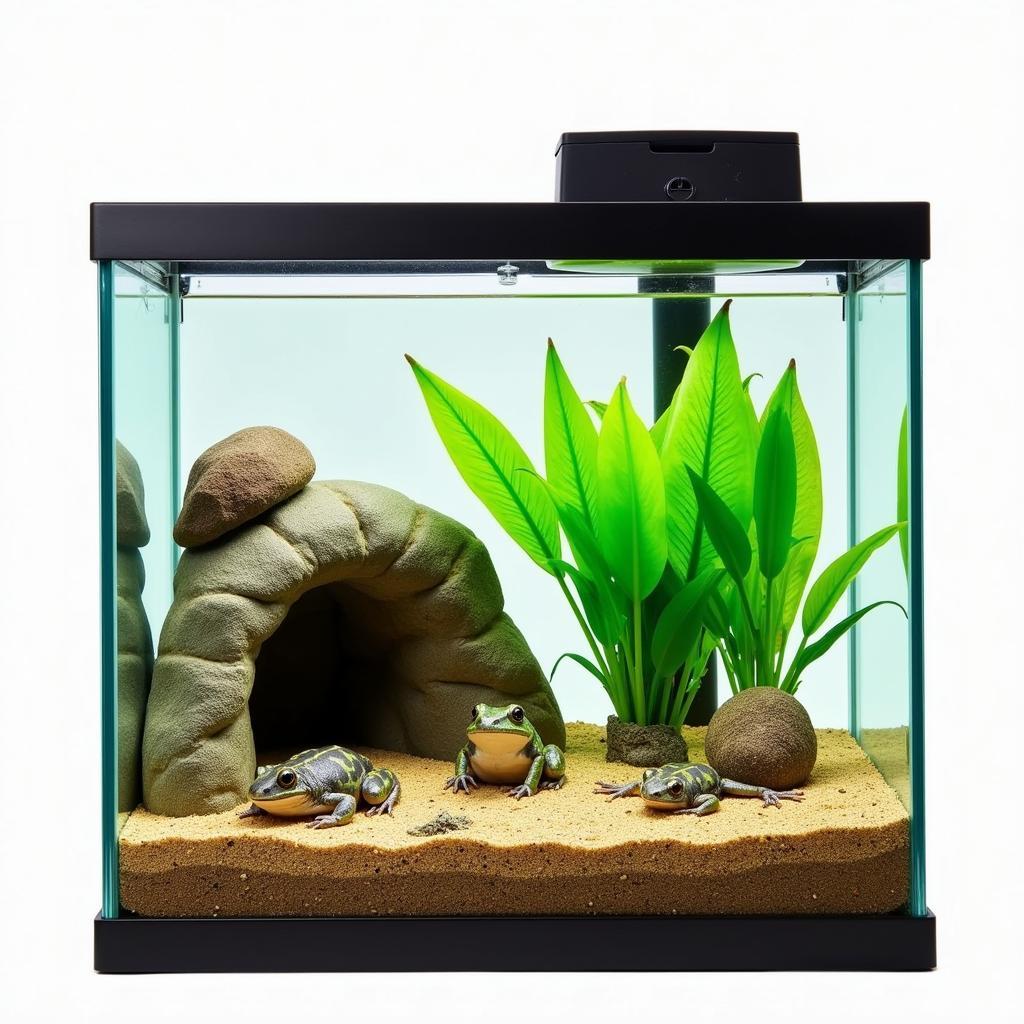The Complete Guide to African Dwarf Frog Care
African dwarf frogs are small, aquatic frogs native to the rainforests of Central and West Africa. These fascinating creatures make charming and low-maintenance pets for both beginner and experienced aquarium enthusiasts. If you’re considering adding these peaceful amphibians to your home, this comprehensive guide will provide everything you need to know about African Dwarf Frog Care.
 African dwarf frog swimming in a planted aquarium
African dwarf frog swimming in a planted aquarium
Setting Up the Perfect Home for Your African Dwarf Frogs
African dwarf frogs thrive in a well-maintained aquarium that mimics their natural habitat. These frogs are fully aquatic and will spend their entire lives underwater.
Tank Size and Water Parameters
- Tank Size: A 5-gallon tank is sufficient for a pair of African dwarf frogs. However, a larger tank (10 gallons or more) is recommended for groups of three or more.
- Water Temperature: Maintain a water temperature between 78-82°F (25-28°C). Use a reliable aquarium heater to keep the temperature stable.
- Water pH: Aim for a slightly acidic to neutral pH range of 6.5-7.5.
- Water Hardness: African dwarf frogs prefer moderately hard water.
- Filtration: A gentle filter with an adjustable flow rate is essential to keep the water clean without creating strong currents.
Substrate and Decorations
- Substrate: Choose a smooth, sand substrate that won’t scratch your frogs’ delicate skin. Avoid gravel as they can accidentally ingest it while feeding.
- Plants: Live or silk plants provide hiding spots and mimic their natural environment. Java ferns, Anubias, and Java moss are excellent choices.
- Rocks and Caves: Smooth rocks, caves, and driftwood offer additional hiding places and enrich their environment.
 Ideal tank setup for African Dwarf Frogs
Ideal tank setup for African Dwarf Frogs
Feeding Your African Dwarf Frogs
African dwarf frogs are carnivores and require a diet rich in protein.
- Food Options: Feed them a variety of sinking frog pellets, bloodworms, brine shrimp, daphnia, and chopped earthworms.
- Feeding Frequency: Young frogs (under 6 months) should be fed daily. Adults can be fed every other day.
- Feeding Amount: Offer as much food as they can consume within 2-3 minutes.
Pro Tip from Dr. Anya Patel, Aquatic Veterinarian: “Always remove uneaten food after feeding to maintain water quality. Overfeeding can lead to poor water conditions and health problems.”
Maintaining Water Quality
Clean water is crucial for the health and well-being of your African dwarf frogs.
- Water Changes: Perform a 25% water change weekly using a gravel vacuum to remove debris and uneaten food.
- Dechlorination: Always treat tap water with a water conditioner to remove chlorine and chloramines before adding it to the tank.
- Water Testing: Regularly test the water parameters (pH, ammonia, nitrite, nitrate) to ensure they are within the acceptable range.
Common Health Concerns
While generally hardy, African dwarf frogs can be susceptible to certain health issues.
- Dropsy: This serious condition is characterized by bloating and fluid retention. It can be caused by bacterial infections, organ failure, or parasites.
- Red Leg Syndrome: A bacterial infection that causes redness on the legs and belly. It can be fatal if left untreated.
- Fungus: White, cotton-like growths on the skin are a sign of fungal infections.
If you notice any signs of illness, consult an aquatic veterinarian immediately.
African Dwarf Frog Tank Mates
African dwarf frogs are peaceful and social animals that can coexist with other peaceful species.
- Ideal Tank Mates: Small, non-aggressive fish like neon tetras, ghost shrimp, and African dwarf shrimp make suitable tank mates.
- Incompatible Tank Mates: Avoid housing them with large, aggressive fish or fish that may mistake them for food.
For a comprehensive guide on compatible tank mates, check out our article: african dwarf frog care guide lifespan tank mates.
Conclusion: Providing the Best Care for Your African Dwarf Frogs
With proper African dwarf frog care, these fascinating creatures can live up to 5 years or more in captivity. By providing a suitable habitat, a nutritious diet, and maintaining good water quality, you can ensure your African dwarf frogs thrive and bring you years of joy.
FAQs about African Dwarf Frog Care
1. Can African dwarf frogs live in tap water?
No, tap water contains chlorine and chloramines that are harmful to frogs. Always treat tap water with a water conditioner before adding it to the tank.
2. How often should I clean my African dwarf frog tank?
Perform a 25% water change weekly and use a gravel vacuum to remove debris and uneaten food.
3. Can I handle my African dwarf frogs?
It’s best to minimize handling as their skin is delicate and can be easily damaged.
4. Why is my African dwarf frog floating?
Floating can be a sign of several issues, including swim bladder problems, poor water quality, or illness.
5. What are some signs of a sick African dwarf frog?
Signs of illness include lethargy, loss of appetite, bloating, skin discoloration, and difficulty swimming.
For more fascinating facts about these unique creatures, visit our african dwarf frog facts page.
Need Help with Your African Dwarf Frog Care?
Contact us! We have a team of experts available 24/7 to assist you.
Phone: +255768904061
Email: [email protected]
Address: Mbarali DC Mawindi, Kangaga, Tanzania.
Explore more about creating amazing aquatic habitats on our website! Learn about setting up a stunning african cichlids fish tank setup or discover the diverse wildlife found in the african congo rainforest animals. We’re here to guide you through every step of your aquatic journey!


